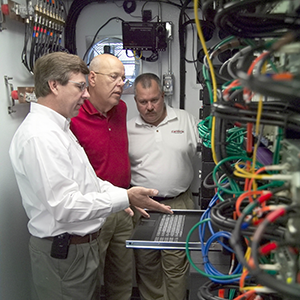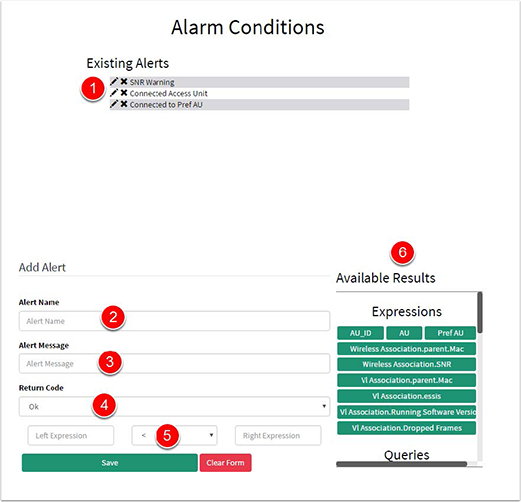GridObserver® MONITORING

Click for larger image.
GridObserver®’s configuration is highly customizable allowing a high degree of flexibility in monitoring a network. This flexibility arises from the methods by which GO collects and continues in how that data is processed into the information powering the Actionable Intelligence Engine.
GridObserver® monitors widely and deeply across the entire network. The ability for GridObserver® to monitor a network deeply refers to its ability to dive into all of the different devices of the network using subatomic modeling. This not only tells you that it’s not working, but going into the device itself to understand why it’s not working. It provides a complete visibility of smart grid data at all levels of the network, both physical and virtual. The breadth of its monitoring capabilities includes almost all hardware equipment platforms, including licensed and unlicensed microwave radios, switches, routers, servers and other related equipment. Its monitoring depth includes providing visibility into the MPLS/ATM/SONET/Routing/DWDM layers of the network.
This Manager of Managers (MOM) performs advanced level tracking and predictive event correlation. It’s patent-pending MIB (Management Information Base) browser enables rapid integration of new equipment and equipment types as they are added into the network. Along with it’s in depth monitoring, it is able to report a “Quick Glance” summary for all network elements to give a broad idea how everything is functioning.
GridObserver® is fully web-enabled for monitoring anytime, anywhere. It has intelligent auto-notification for real-time escalation. It monitors not only the physical devices, but the virtual aspects within the device and the relationships it possesses with other devices. This subatomic monitoring is unique to GridObserver®. It doesn’t just monitor the superficial edge of the device. It monitors every element in the network, and is able to tell if either a physical or a virtual relationship is altered or cut off completely. GridObserver® can also detect missing relationships that should exist between devices, which will permit adjustments to maximize capacity.
Compatibility

To be a true Manager-of-Managers GridObserver® maintains compatibility with network equipment from many vendors. We achieve this compatibility thanks to the Internet Engineering Task Force (IETF) and the Simple Network Management Protocol(SNMP) component of the Internet Protocol Suite. These standards define a format by which an equipment vendor may define Management Information Base(MIB) files. These MIB files tell us what data is available on a device for monitoring. GridObserver® currently supports devices from over 500 vendors thanks to this metadata. These standards also enable rapid integration of new equipment types with GridObserver® as they become available.
The data within a MIB file can be thought of as a collection of questions that a device can respond to. These responses will be in the form of a single value or a table of data. GridObserver® comes preloaded with support for over 47,000 standard and vendor proprietary tables, as well as an additional 67,000 single value parameters.
However, not all devices support SNMP and some make limited data available over the protocol. In these instances, GridObserver® resorts to other means of data collection. If a device does not have SNMP it will have another means of communications. Examples are SSH, Telnet, Serial, HTTP, HTTPS and TL1. Grid Observer supports data collections for each of these protocols. For protocols like TL1 which define a standard alarm table we collect and propagate those alarms. Because there is no standard for metadata exchange for these protocols, we define collection parameters explicitly.
GridObserver® is designed so that all data ingested into the system follow as common path for processing, alerting, and storage. This allows the Actionable Intelligence Engine to operate on turning collected data into valuable information independent of the means of collection.
In addition to poll based data acquisition GridObserver® supports messages pushed from equipment such as SNMP Traps and Syslog Messages. As a signal source pushed messages contain value, but the signal can be noisy. GridObserver® facilitates cutting through this noise with tools like: Message Volume Summary Reports, Performance Indicators, and Incident Anomaly Analysis. Automatic extraction of new search vectors appearing in message sources of the previous day help in identifying performance indicators and in identifying new issues on the network.
Device Classes
A single physical kind of device may play multiple roles on a network. For example, a Cisco Layer 3 switch can function as a top of rack switch, or as a router in the network. An NMS that solely classifies devices by manufacturer and model will be limited in how they are able to monitor these devices when used in different roles. GridObserver® device classes allow for different data collection, processing and notifications for a device based on its role.
This collection of data points to be collected, how they are to be processed, stored and thresholds for alarms are a probe. Probes may be shared with multiple device classes. This prevents having to keep things in sync when you have data that can be shared across several device classes.
Notifications

Click for larger image.
GridObserver® has a robust notification system. In defining an alert message, it allows for customizing equipment source (by class, site, group, etc.), as well as customizing alert levels, time thresholds before a notification is sent, and frequency of reminder notifications until the issue is resolved. The system supports integration with third party systems, such as PagerDuty.
The repercussions of any one of these systems going down or operating at less than peak efficiency could be catastrophic. By using GridObserver®’s KPIs in order to report on the health of the network, network downtime will be on a decline, by providing a clear picture of what is truly happening in a network.
Some Manufacturers supported by GridObserver®
| American Power Conversion Corp. | Hitachi, Ltd. | Schneider Electric |
| Andover Controls Corporation | HUAWEI Technology Co.,Ltd | Siemens AG |
| Apple Computer, Inc. | IBM | SonicWALL, Inc. |
| ArrowPoint Communications Inc. | Intel Corporation | Sonix Communications, Ltd. |
| Artel | Jetstream Communications | Sonoma Systems, Inc. |
| Aruba Networks Inc | Johnson Controls, Inc. | Sonus Networks, Inc. |
| Ascend Communications Inc. | Juniper Networks/Funk Software | Sony |
| AT&T | Juniper Networks, Inc. | Spectracom Corporation |
| Avanti Technology, Inc. | Juniper Networks/Unisphere | Stratacom |
| Avaya Communication | LANOPTICS LTD., Israel | Stratus Computer |
| Axis Communications AB | Lantronix | Sun Microsystems |
| Banyan Systems Inc. | Lexmark International | Super Micro Computer Inc. |
| BridgeWave Communications | LightStream Corp. | Symantec Corporation |
| Broadband Access Systems, Inc. | Linksys | Symmetricom |
| Broadcom Corporation | Lucent Technologies | Symplex Communications Corp. |
| Brocade Communication Systems, Inc. | Madge Networks, Inc. | Synaccess Networks, Inc. |
| Foundry Networks, Inc | Marconi | Synology Inc. |
| Brother Industries, Ltd. | Mariposa Technology, Inc. | SynOptics |
| Cambium Networks Limited | Microcom | Teracom Telematica Ltda. |
| Chateau Systems, Inc | Microsoft | Terawave Communications, Inc. |
| Check Point Software Technologies Ltd | MikroTik | Tranzeo Wireless Technologies Inc. |
| Cisco Systems | Minolta Co., Ltd. | Trend Micro Inc. |
| Citrix Systems Inc. | Mission Critical Software, Inc. | Tripp Lite |
| Clearpoint Research Corp. | Mitel, Corp. | Ubiquiti Networks, Inc. |
| Compaq | Motorola | Verilink Corp |
| Cosine Communications | Moxa Technologies Co., Ltd. | VERITAS Software Corp. |
| Dataprobe Inc. | MTS Allstream Inc. | VMware Inc. |
| Dell Inc. | NetBotz | WatchGuard Technologies Inc. |
| D-Link Systems, Inc. | Netgear | Wellfleet |
| Dynatech Communications | Netscaler | Xerox |
| Enatel Ltd | NetScreen Technologies, Inc. | Xircom |
| Nokia | Xylan Corp. | |
| ZyXEL Communications Corp. |
Quick Look:
Network Monitoring
- GridObserver® provides all encompassing visibility of smart grid data throughout all levels of the network.
- Monitoring using GridObserver® takes into account not just physical devices and connections, but the virtual aspects that exist within and without any discrete device on the network.
- GridObserver® offers a user defined “Quick Glance” summary for all network elements.
- GridObserver® is a full-service network management framework that works by looking widely (across many vendors WiMAX, Microwave, Switches, Routers, etc.) and deeply (into the MPLS/ATM/SONET/Routing/DWDM) layers of the network.


